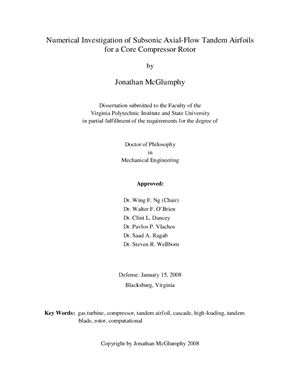Virginia Polytechnic Institute and State University (Virginia/USA),
114 p., Jonathan McGlumphy, 2008 year
Speciality "Mechanical engineering"
A high hub-to-tip ratio 3-D blade geometry was developed based upon the best-case tandem airfoil configuration from the 2-D study. The 3-D tandem rotor was simulated in isolation in order to scrutinize the fluid mechanisms of the rotor, which had not previously been well documented. A geometrically similar single blade rotor was also simulated under the same conditions for a baseline comparison. The tandem rotor was found to outperform its single blade counterpart by attaining a higher work coefficient, polytropic efficiency and numerical stall margin. An examination of the tandem rotor fluid mechanics revealed that the forward blade acts in a similar manner to a conventional rotor. The aft blade is strongly dependent upon the flow it receives from the forward
blade, and tends to be more three-dimensional and non-uniform than the forward blade.
Speciality "Mechanical engineering"
A high hub-to-tip ratio 3-D blade geometry was developed based upon the best-case tandem airfoil configuration from the 2-D study. The 3-D tandem rotor was simulated in isolation in order to scrutinize the fluid mechanisms of the rotor, which had not previously been well documented. A geometrically similar single blade rotor was also simulated under the same conditions for a baseline comparison. The tandem rotor was found to outperform its single blade counterpart by attaining a higher work coefficient, polytropic efficiency and numerical stall margin. An examination of the tandem rotor fluid mechanics revealed that the forward blade acts in a similar manner to a conventional rotor. The aft blade is strongly dependent upon the flow it receives from the forward
blade, and tends to be more three-dimensional and non-uniform than the forward blade.

